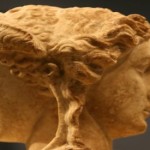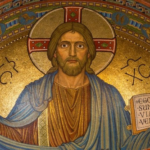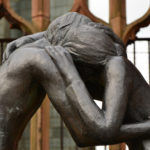We run our website the way we wished the whole internet worked: we provide high quality original content with no ads. We are funded solely by your direct support. Please consider supporting this project.

The Trinity and the Crucified God
God has always been willing to stoop to accommodate the fallen state of his covenant people in order to remain in a transforming relationship with them and in order to continue to further his sovereign purposes through them. This is revealed in the life and death of Jesus.
Out of love for humankind, Jesus emptied himself of his divine prerogatives, set aside the glory he had with the Father from before the foundation of the world, became a human being, and bore our sin as he died a God-forsaken death on Calvary (Phil 2:5-7). Though Jesus remained fully God, he entered into total solidary with humanity by becoming a full human being. And though Jesus remained sinless, he entered into total solidarity with our sin and condemnation, to the point that Paul boldly proclaimed that Christ in some real sense became our sin and became our curse (2 Cor 5:21; Gal 3:13). The cross reveals a God of covenantal love who is not above setting aside his glory to accommodate the limitations and sin of his fallen people.
So too, the cross reveals a God of unfathomable humility and mercy who is not above stooping to appear far less beautiful than he actually is—to appear as a guilty, crucified criminal!—in order to save us and to continue to achieve his sovereign purposes through his covenant people. It thus reveals a God who is willing to condescend to appear in ways that reflect more of the sin of his people than they reflect the way he actually is, thereby disclosing his sin-bearing character. The humble, self-sacrificial love displayed on the cross reflects the character of God’s very essence (hupostasis, Heb. 1:3) as well as the way God has always been relating to, and working through, his covenant people.
Reflecting on the revelation of the crucified God leads us to the most profound, beautiful, and important mystery of the Christian faith. The fullest and clearest revelation of God’s true nature took place precisely when God stooped to take on a semblance that is antithetical to his true nature. What could be more antithetical to the all-holy God than to, in some sense, become our sin (2 Cor. 5:21)? While this revelation of course never ceases to be wonderfully mysterious, I believe it can be rendered intelligible, but only when we accept that God’s eternal nature is a union of three divine Persons who eternally give themselves wholly to one another in perfect, humble, self-giving love.
As Father, Son and Holy Spirit, God is from all eternity a self-giving God who pours himself out for “another.” Indeed, this is not only something the three Persons of the Trinity do; this is who the triune God eternally is. This is the meaning of the revelation that God is love—the kind of love that is revealed when God stoops to the infinite extreme of becoming a human and dying on a cross for a race of people who could not deserve it less (1 Jn 4:8; 3:16).
The revelation of the Trinity renders the revelation of God on the cross intelligible because it means that when God humbly poured himself out on behalf of humanity by stooping to the furthest extreme possible—viz. by fully identifying with our humanity, our sin, and our judgment—he was not doing something foreign to himself. To the contrary, by stooping in this way, the eternal triune God was simply enveloping humans into the self-giving, triune, love that he eternally is. As paradoxical as it sounds, when God, the Son, stooped to the infinite extremity of experiencing God-forsakenness on the cross, he was manifesting outwardly in time the perfect unity he eternally enjoys with the Father.
Only by understanding the homoousion (Jesus as “one in being” with the Father) of the Nicene Creed as a perfect unity of self-giving Trinitarian love can we simultaneously affirm the unbroken union between the Son and the Father, on the one hand, while affirming the authenticity of Christ’s cry, “Eli, Eli, lama sabachtani,” (“My God, my God why have you forsaken me?) on the other. If we affirm any other sort of unity, then Jesus’ entrance into the God-forsakenness of our sin and bondage to the devil would undermine the unity of the Trinity and thereby virtually destroy the Godhead! Once we understand the divine unity to be other-oriented love, however, then Jesus’ forsakenness can be understood as expressing, rather than undermining, the infinite intensity of this unity, for there could be no greater expression of other-oriented love than this.
Because God’s true eternal nature is a perfect, other-oriented, self-giving fellowship of three divine persons, we can render intelligible the paradoxical claim that God is revealed by becoming something that is not only different from himself (a human being), but that is even utterly antithetical to himself (our sin and God-forsakenness). The infinite intensity of the perfect love that is the eternal character of the triune God is revealed in the fact that God condescended to the furthest extreme possible—viz. into his own self-negation—out of love for a race of rebels who wanted only to crucify him.
For more on this topic, see Greg’s Crucifixion of the Warrior God.
Photo credit: Cea. via Visual hunt / CC BY
Category: General
Tags: Character of God, Cruciform Theology, Love, Nature of God, Trinity
Topics: Attributes and Character, Trinity
Related Reading

Was the Early Church Pacifistic? A Response to Paul Copan (#11)
In Crucifixion of the Warrior God (CWG) I argue that Jesus and Paul instruct Christians to love and bless their enemies and to unconditionally refrain from violence (e.g. Matt 5:39-45; Rom 12:14-21). Moreover, I argue that this was the prevailing attitude of Christians prior to the fourth century when the Church aligned itself with the…

Sermons: The Church – Week Five
In week five of this sermon series, Greg Boyd discusses what the church should look like in the lens of the cross. A universal Church was born out of the ministry of Jesus, and this Church is empowered to look like the Cross. In this sermon, Greg shows us why it’s so important, as the…

Caught Between Two Conflicting Truths
In my previous blog I tried to show that adopting a “Christocentric” approach to Scripture isn’t adequate, as evidenced by the fact that people adopting this approach often come to radically different conclusions. In fact, it seems to me that the “Christocentric” label is often close to meaningless inasmuch as it doesn’t meaningfully contrast with anything. If a “Christocentric”…

Sanctuary
. SantiMB . via Compfight Jamie Wright wrote this penetrating essay of encountering a woman in a moment of extremity and need. It’s a reminder of our great need for a sanctuary, a safe place to come when the world has gone mad and we have nowhere else to go. From her essay: Because,…

Jesus is the Center of the Story
The previous post addressed how the revelation of Christ is the surprising twist that reframes how we must read all that precedes it. Today we’ll look briefly at five supports to this claim. Jesus said, “I have a testimony greater than that of John” (John 5:36). Jesus elsewhere claims that “among those born of women…

The Coming Kingdom & Racial Conflict
In the book of Revelation, we see a glimpse into the future. John says he saw, …a great multitude that no one could count, from every nation, tribe, people and language, standing before the throne and in front of the Lamb. They were wearing white robes and were holding palm branches in their hands. And…
